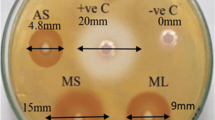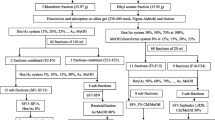In this study, antimutagenic effects of ethanolic extracts of Stachys thirkei and Stachys annua subsp. annua belonging to Lamiaceae family that grow in Duzce of Turkey were investigated on Salmonella typhimurium TA98 and TA100 strains without metabolic activation using Salmonella/microsome test system. Three different concentrations (0.025, 0.05 and 0.1 mg/plate) of the ethanolic extracts of S. thirkei and S. annua subsp. were used as active materials in which the major components were 2-ethylhexanol (30.012%) and 2-beta-pinene (26.40%), respectively. The highest concentration (0.1 mg/plate) of S. thirkei had a moderate antimutagenic effect on the Salmonella typhimurium TA98 strain with a 26.79% inhibition rate. It was also established that the extract of S. thirkei at highest concentration (0.1 mg/plate) exhibited strong antimutagenic effect (with 44.03% maximum inhibition) on TA100 strain. Furthermore, it was found that 0.05 mg/plate ethanolic extract showed moderate antimutagenic activity with 25.55% inhibition rate. The highest concentration (0.1 mg/plate) of ethanolic extract of S. annua subsp. showed moderate antimutagenic activity on both Salmonella typhimurium TA98 and TA100 strains with inhibition rates of 20.39 and 22.13%, respectively. No antimutagenic activity on Salmonella typhimurium TA98 and TA100 strains was observed at the lowest doses of both plant species. As a result, it is concluded that S. thirkei and annua subsp. have antimutagenic activity and further studies may be recommended in terms of different parameters.

Similar content being viewed by others
References
J. M. Pezzuto, Biochem. Pharm., 2, 121 – 133 (1997).
G. Topcu and A. Ulubelen, J. Mol. Struct., 834 – 836, 57 – 73 (2007).
K. Deepti, K. R. Amperayani, N. S. Yarla, et al., Pharm. Chem. J., 51(4), (2017).
M. Nakipoglu and H. Otan, Anadolu J. AARI, 4(1), 70 – 93,(1992).
E. K. Dagcý, M. Izmirli, and M. Digrak, KSÜ Fen ve Mühendislik Dergisi, 5(1), 38-46 (2002).
P. H. Davis (Ed.), Flora of Turkey and the East Aegaen Islands, Vol. 7, Edinburg University Press (1982).
T. Baytop, Farmasotik Botanik Ders Kitabý, Ýstanbul Üniversitesi Eczacýlýk Fakültesi, No: 3687 (1991)
Leblebici Sema, Doctoral Thesis, Turkey (2011).
L. Watson and M. T. Dallwitz, The Families of Flowering Plants, Oxford University Press, London. (1978).
T. Baytop. Türkiye’de Bitkiler ile Tedavi, Ýstanbul Üniversitesi Yayýnlarý, Turkiye, (1984).
G. Renda, N.Y. Bekta, B. Korkmaz, et al., Marmara Pharm. J., 21(2), 278 – 285 (2017).
L. A. Mitscher, S. Drake, S. R. Gollapuri, et al. (Eds.), Antimutagenesis and Anticarcinogenesis Mechanisms, Plenum Press, New York (1986).
J. H. Weisburger, Mutat. Res., 480 – 481, 23 – 35 (2001).
S. Bhattacharya, Res. J. Med. Plants 5(2), 116 – 126 (2011).
V. Karaker, S. Joshi, and S. L. Shinde, Mut. Res., 468, 183 – 194 (2000).
S. Sato and I Tomita, J. Health Sci., 47(1), 1 – 8 (2001).
F. I. Abdulaev, L. Riveron-Negrete, H. Caballero-Orgeta, et al., Toxicology In Vitro, 17, 731 – 736 (2003).
M. Taherkhani, Pharm. Chem. J., 48, 11 (2015).
KEW Science, Royal Botanics Garden, Plants of the World Online. http: // powo.science.kew.org / taxon / urn:lsid:ipni.org:names: 77171996-1 (Date of access: 06 May 2020).
I. Uysal, J. Environ.Biol., 31, 141 – 147 (2010).
C. Unsal, H. Vural, and G. Sariyar, Turk. J. Pharm. Sci., 7(2), 139 – 150 (2010).
Z. C. Arituluk and N. Ezer, Hacettepe Univ. J. Fac. Pharm., 32, 179 – 208 (2012).
E. Altundag and M. Ozturk, 2nd Intern. Geo. Sym.-Mediter. Environ., 19, 756 – 777 (2011).
D. Tunali Erkan, and B. Dulger, Duzce Univ. J. Sci. Technol., 4, 886 – 893 (2016).
T. Askun, E. M. Tekwu, F. Satil, et al., BMC Complem. Altern. Med., 13, 365 – 375 (2013).
A. C. Goren, F. Piozzi, E. Akcicek, et al., Phytochem. Lett., 4, 448 – 453 (2011).
A. Venditti, A. Bianco, and L. Quassinti, Chem. Biodiv., 12, 1172 – 1183 (2015).
M. Digrak, M. H. Alma, and A. Ilcim, Pharm. Biol., 39(5), 346 – 350 (2001).
M. Alpay, G. Dülger, and E. Karabacak, Indian J. Med. Res. Pharm. Sci., 4(12), 68-74. (2017).
S. Karakaya and A. Kavas, J. Sci. Food Agric., 79, 237 – 242 (1999).
B. J. Dean, T. M. Brooks, G. Hodsonwalker, et al., Mutat. Res., 153, 57 – 77 (1985).
EBPI, http: // www.ebpi.ca/Muta-ChromoPlate%20Power% 20Point%20Presentation%20-%20Extended.pdf (Eri°i tarihi: 29 April 2020).
D. M. Maron and B. N. Ames, Mutat. Res., 113, 173 – 215 (1983).
P. S. Negi, G. K. Jayaprakasha, B. S. Jena, Food Chem., 80, 393 – 397 (2003).
A. A. Basaran, T. W. Yu, M. J. Plewa, et al., Teratogen. Carcinogen. Mutagen., 16, 125 – 138 (1996).
I. Gurbuz, E. Yesilada, and B. Demirci, J. Ethnopharmacol., 148, 332 – 336 (2013).
G. E. Barboza, J. J. Cantero, C. Núñez, et al., Tomo, 34(1–2), 7 – 365 (2009).
M. Sharmila, M. Rajeswari, I. Jayashree, et al., Intern. J. App. Adv. Sci. Res., 1(1), 2456 – 3080 (2016).
C. C. Santos, M. S. Salvadori, V. G. Mota, et. al., Neurosci. J., 1 – 9 (2013).
R. O. Silva, F. B. Sousa, S. R. Damasceno, et al. Fundam. Clin. Pharmacol., 28(4), 455 – 464 (2013).
K. R. Mari and S. Muthukrishnan., J. Pharmacog. Phytochem., 7(2), 681 – 693 (2018).
Kocak Mehmet Sefa, M.S Doctoral Thesis, Turkey (2015).
Cigdem Harun, Master’s Thesis, Turkey (2013).
B. Salehi, S. Upadhyay, I. E. Orhan, et al., Biomolecules, 9, 738, 1 – 34 (2019).
T. Y. Shin, Immunopharm. Immunotoxicol., 26(4), 621 – 630 (2004).
A. Delazar, S. Celik, R. S. Gokturk, et al., Pharmazie, 60(11), 878 – 880 (2005).
J. Kukic, S. Petroviæ, and M. Niketic, Biol. Pharm. Bull., 29(4), 725 – 729 (2006).
Z. Amirghofran, M. Bahmani, A. Azadmehr, et al., Neoplasma, 53, 428 – 433 (2006).
Z. Amirghofran, M. Bahmani, A. Azadmehr, et al., Med. Sci. Monit., 13(6), 145 – 150 (2007).
E. Háznagy-Radnai, B. Réthy, S. Z. Czigle, et al., Fitoterapia, 79(7–8), 595 – 597(2008).
P. C. H. Hollman, M. G. L. Hertog, and M. B. Katan, Food. Chem., 57, 43 – 46 (1996).
J. A. Milner, Nutr. 131(3), 1027 – 1031 (2001).
Y. Shukla and P. Taneja, Environ. Pathol. Toxicol. Oncol., 21(3), 259 – 265 (2002).
D. Madhavi, K. R. Devil, K. K. Rao, et al., Environ. Biol., 28(1), 115 – 117 (2007).
Acknowledgments
This study was supported by Duzce University Scientific Research Fund (Project Number, 2019.11.01.908).
The authors are grateful to Scientific and Technological Research Application and Research Center of Duzce University for GC-MS analysis, Assoc. Prof. Dr. Haydar GOKSU and Assoc. Prof. Dr. Nedim ALTIN for chemicals; and Ilker Kiliccioglu and Bahar Gedik for their scientific assistance.
Author information
Authors and Affiliations
Corresponding author
Rights and permissions
About this article
Cite this article
Rasgele, P.G., Dulger, G. Chemical Compositions and Antimutagenic Effects of Ethanolic Extracts of Stachys Thirkei and Stachys Annua subsp. Annua Using the Ames Assay. Pharm Chem J 54, 1255–1262 (2021). https://doi.org/10.1007/s11094-021-02351-x
Received:
Published:
Issue Date:
DOI: https://doi.org/10.1007/s11094-021-02351-x




